The day we crossed the border into Canada, the weather closed in and memories of previous soggy times in the west of the country settled on our heads. Fortunately or otherwise our experience so far has been similar, with some dry, sunny or mainly clearish days dotted among the wet, cool, windy ones. It seems that we have arrived a little late in the season but are taking every available opportunity to get out and about.
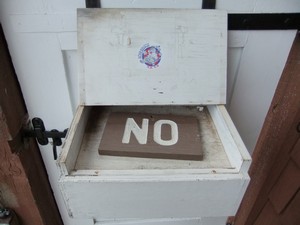 We begin this Canadian visit in New Brunswick at Mactaquac Provincial Park, chosen for the pleasure of pronunciation. Some
readers will recognise it as belonging to a similar genre as Menominee and Shipshewana and will no doubt be enjoying the
introduction to such a delightful new placename.
We begin this Canadian visit in New Brunswick at Mactaquac Provincial Park, chosen for the pleasure of pronunciation. Some
readers will recognise it as belonging to a similar genre as Menominee and Shipshewana and will no doubt be enjoying the
introduction to such a delightful new placename.
We arrive early evening to find the entrance booth unstaffed. Often in such circumstances, there are self registration envelopes to deposit the fee for a night's camping. In wet climes, these are usually to be found in some sort of rain shelter and spying a wooden box I ask Sterling if there is anything in it. He opens the lid and looking inside starts to laugh; this is not "I'm vaguely amused", this is eyes streaming, body convulsing, unable to speak laughter. It took us some time to calm down and while the photograph isn't that interesting it does explain the answer to my question.
The theme of exceptional names continues at Kouchibouguac
National Park where salt marshes, bogs, shoreline and barrier islands
come together in an amazing collage of colour along a narrow strip of coast backed by dense evergreen woods.

Whilst out on the bike trails one afternoon we stop at an area known as Marilyn’s Wigwam, a plastic facsimile of the bark wigwams built in this area. Given it's already gone five o'clock we speculate that the program of the day has probably finished but Sterling claims he can still hear something going on. Calling out a cheery greeting I open the flap to catch sight of a man scurrying out the back, trousers around his ankles, his partner in crime looking sheepish as I quickly make my apologies and retreat. You just never know what you're going to see out in the wild! (For decencies sake, no photographs of this incident will be posted)
We have held Canadian National Parks in high regard since our visit to Banff, Jasper, Yoho and Kootenay back in 2004. While Kouchibouguac wins hands down in terms of its name, we felt it didn't quite live up to the promise of a National Park. The US National Park Service has an additional designation of National Seashore and from what we've seen of these, Kouchibouguac would fit very happily into such a category. Realising that Canada groups all such nationally protected areas under one label helped us adjust expectations somewhat.
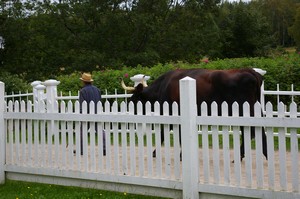 Kings Landing Historical Settlement deserves a quick mention before we leave New Brunswick.
It's a living museum with staff employed throughout the village, in occupations typical of the period. They are in character,
some more successfully than others, talking about their trade, sharing the local gossip or responding to questions from
their characters’ perspective.
Kings Landing Historical Settlement deserves a quick mention before we leave New Brunswick.
It's a living museum with staff employed throughout the village, in occupations typical of the period. They are in character,
some more successfully than others, talking about their trade, sharing the local gossip or responding to questions from
their characters’ perspective.
Some of the staff produce goods that are used in the maintenance and upkeep of the settlement. One of these is the finish carpenter who makes shingles as well as decorative wood trims for use inside the houses. When he introduced himself, I heard Finnish carpenter and immediately jumped to a number of erroneous conclusions, the least being that his unusual style of beard was typical of Finland in the 1700's. Thank goodness I didn't comment on it!
As with all good villages, it has its pub; the Kings Head Inn, where produce from the numerous vegetable patches around the village are used in recipes of the day. We have a light lunch and finish by sharing the pie sampler; I don't need to clarify where the lion's share went. Sterling declares them all delicious and inspired by this I buy a small booklet, with recipes from the menu.
It quickly becomes obvious that the recipes leave something to be desired and are not perhaps as tried and tested as one would ideally like. I make a Buttermilk Pie, with some considerable reduction in sugar quantity and the result is delicious. The buttermilk and nutmeg combine to give it the flavour of American pancakes and it is promptly renamed. Sterling has a well documented fondness for pies and now that there is one with pancake in its name, he has taken to declaring "It's never too early for pie!" when asked what he wants for breakfast.
Taking the remnant of the pie with us, we cross the Confederation Bridge and arrive in Prince Edward Island, helpfully abbreviated to P.E.I. by residents and visitors alike. It is the smallest of Canada's provinces and the most densely populated, this latter fact not evident as we drive west on arrival. It differs from every other area of the east that we have seen so far this year; it's woodlands largely cleared, making way for agriculture. Instead of populace we see potato fields.
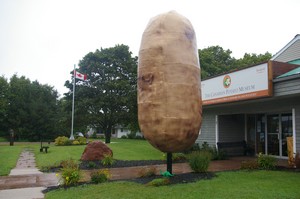 P.E.I. is the potato capital of the world. It produces more potatoes per capita than anywhere else on the globe, an enormous
10,000 kilogrammes per head, and celebrates the fact at the Canadian Potato Museum in
O'Leary. We knew we were in for a treat when we caught sight of the Big Spud: a huge brown blob on a stick, strategically
placed by the front door, it might be unidentifiable out of context but in its existing location it could be nothing other than
the museum's namesake.
P.E.I. is the potato capital of the world. It produces more potatoes per capita than anywhere else on the globe, an enormous
10,000 kilogrammes per head, and celebrates the fact at the Canadian Potato Museum in
O'Leary. We knew we were in for a treat when we caught sight of the Big Spud: a huge brown blob on a stick, strategically
placed by the front door, it might be unidentifiable out of context but in its existing location it could be nothing other than
the museum's namesake.
Inside was a truly mind-boggling collection of potato related history, myth, fact, science, farming equipment and methodology
along with potato inspired art and of course Mr Potato Head himself. Being the daughter of an Irish mother and Polish father,
I do not take potatoes lightly; they are in my blood and while I do not eat nearly as many as I did as a child, when they were
an obligatory part of every meal, I still hold them in high regard.
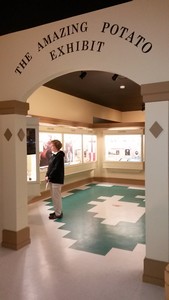
A small cafe in the museum serves potatoes in various guises and nothing else. We lunched on potato soup and potato scones with a side of chips, sprinkled with both salt and sugar. Much is claimed of the humble potato, including its nutritional qualities and while the fries were delicious there was no mention of the cooking method or condiments.
So, if you find yourself in P.E.I. on a wet afternoon and want to broaden your knowledge of a particularly interesting root vegetable I can highly recommend a visit to this most illuminating establishment; just don't laugh too loudly as it seems to upset the staff.
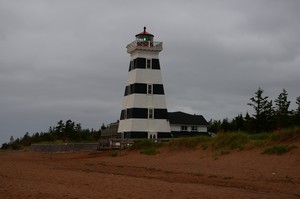 We spend our first night on the island at Cedar Dunes Provincial Park, a scrap of land on the western coast with a
few campsites, that distinguishes itself through an extensive use of emerald green paint. The skies are heavy, the sea steel
grey, as we walk the short distance along the red sand beach towards the West Point lighthouse. It's not long before a gentle
drizzle settles in and persists, more on than off, for the next two days. P.E.I's lighthouses are ubiquitous, many built in a
very particular rectangular wooden style unlike the standard conical shape usually associated with these beacons. The outside
is painted in deep horizontal black and white bands, looking distinctive even on this overcast day. The lighthouse became
operational in 1875 and is still lighting the way albeit now powered by electricity rather than oil. It is unusual in a number
of regards; it is the only lighthouse in Canada that is also an inn and the only one operated by a community group rather than
the federal government. Going up, each flight of stairs is narrower and steeper, the final one more like a ladder to be climbed
before stepping up into the lantern and, for me, the real beauty of this lighthouse: its green lense glass and consequently
tinted light.
We spend our first night on the island at Cedar Dunes Provincial Park, a scrap of land on the western coast with a
few campsites, that distinguishes itself through an extensive use of emerald green paint. The skies are heavy, the sea steel
grey, as we walk the short distance along the red sand beach towards the West Point lighthouse. It's not long before a gentle
drizzle settles in and persists, more on than off, for the next two days. P.E.I's lighthouses are ubiquitous, many built in a
very particular rectangular wooden style unlike the standard conical shape usually associated with these beacons. The outside
is painted in deep horizontal black and white bands, looking distinctive even on this overcast day. The lighthouse became
operational in 1875 and is still lighting the way albeit now powered by electricity rather than oil. It is unusual in a number
of regards; it is the only lighthouse in Canada that is also an inn and the only one operated by a community group rather than
the federal government. Going up, each flight of stairs is narrower and steeper, the final one more like a ladder to be climbed
before stepping up into the lantern and, for me, the real beauty of this lighthouse: its green lense glass and consequently
tinted light.
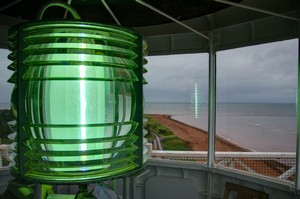
P.E.I. has its own national park but, as in the case of
Kouchibouguac, it's not of the ilk of large scale dramatic parks. For
all that, it’s another place where the hues of sky, sea, grasses and sand combine to create a stunning feast of colour. At
Cavendish campground we park on the small bluffs overlooking the coast and after a couple of days, as the skies clear, the
scene is flooded with rich colours that leave a lasting impression in the mind. We spend time wandering on the shoreline,
watching the waves, laden with red sand, rushing up the sloping beach before falling back, leaving their cargo of shells and
pebbles strung out in tide lines.
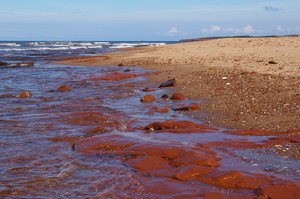
On a totally bizarre note, we drop in to visit the Dalvay-by-the-Sea historic site only to be greeted by a cardboard cut-out of the second in line to the British throne, along with his wife! I experience a momentary disorientation but a quick shake of the head reminds me of the Commonwealth and Canada’s Head of State. As we’ve observed before it’s a place where Sterling and I feel very at home; there are still Smarties lying next to the Reese’s in the supermarkets although regrettably we’ve seen no Hobnobs this time around!